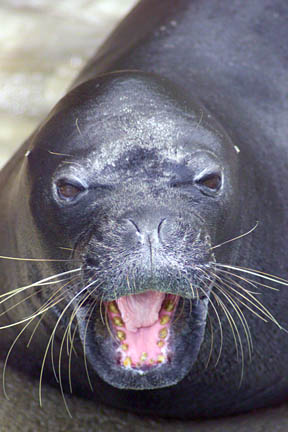
[ IN THE WATER ]
Hawaiian monk seal Nuka'au got excited as noontime feeding and training time approached. The monk seal is highlighted at the Waikiki Aquarium as the animal of the month.
Monk seals shine
Twenty-three-year-old Nuka'au and 20-year-old Makaonaona -- two male monk seals -- have been splashing around in their home at the Waikiki Aquarium for the past two decades, and this month are in the spotlight as the aquarium's "Animal of the Month."
The intent of the program, one of the institution's centennial programs, is to raise awareness of island fauna, and the monk seal has made headlines recently, from "the groper" that was harassing swimmers and eventually shipped off to Johnston Atoll, to the injured creature airlifted from Kauai to Oahu for surgery a few weeks ago.
Waikiki Aquarium
Where: 2777 Kalakaua Ave.Hours: 9 a.m. to 4:30 p.m. daily, except Christmas and New Year's Day
Admission: $7 general; $5 for kamaaina, active-duty military with ID and seniors; $3.50 for children ages 13 to 17; free for children under 12.
Info: 923-9741 or www.waquarium.org
Spotlight animals for 2004
July: Kihikihi, the Moorish idol
August: Lau'wiliwili nukunuku'oi'oi, the Aquarium's signature fish
September: Mano, shark
October: Nohu, scorpion fish
November: 'Opae ula, red pond shrimp
December: Puhi, general term for eels
January: Ulua, general term for jacks
February: Wana, venomous urchin
The marine mammals belong to a group known as the Pinnipeds, which includes seals, sea lions, fur seals and walruses. Unlike sea lions, seals do not walk on their flippers and they vocalize with guttural noises rather than a bark.
Hawaiian monk seals are spend about a third of their time resting and sleeping on shore to conserve energy for hunting and foraging. They can remain under water for 15 to 20 minutes and can dive more than 1,000 feet.
"They are very clever animals," said Jerry Crow, curator of the Waikiki Aquarium, of the two resident males Maka, who was orphaned by his mother at a pup, and Naku, who arrived when he was about 2 years old. "They pick up behaviors so quickly we need to keep finding ways to challenge them," Crow said.
For the remainder of June, visitors can watch feeding demonstrations and learn more about the creatures. Reef fish, octopus and lobsters are the seals' choice for meals, Crow said. The seals eat about 11 pounds of food a day.
THE HAWAIIAN monk seal is the fourth animal to be featured in the aquarium's animal-of-the-month program. July's creature will be kihikihi, the Moorish idol that received screen time in "Finding Nemo," through the character Gil.
Hawaiian monk seals are considered endangered species, with an estimated population of 1,200 statewide, and all of the research conducted at the aquarium is under a permit with the National Marine Fishery Service.
Crow's current study is blubber, and how its thickness changes over time and with the seasons. The aquarium's seals also participated in a hearing study.
One experiment that can't be conducted in the lab is the seals' mating ritual. Crow explained that keeping females in the wild increases the odds of reproduction.
Click for online
calendars and events.

